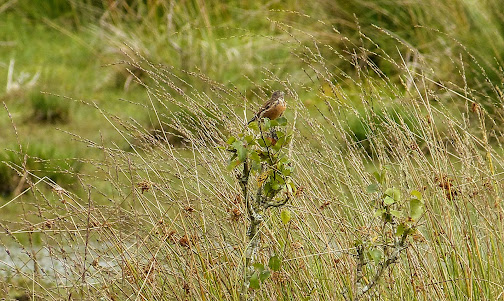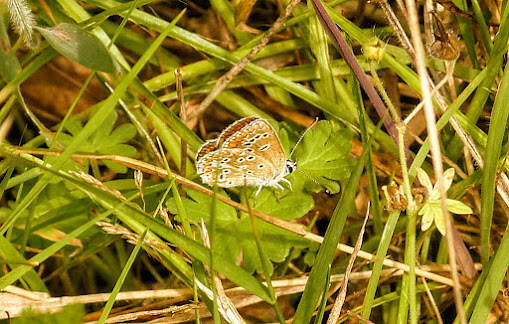Saturday 19th August 2023.
Though the day started off a bit showery, the rain moved on and the rest of the day was a mixture of bright, warm sunshine and a breezy south-westerly. Of late, Titchfield Haven looked like the top candidate to go birding and once Andy Fisher told me that the Wood Sandpiper was still present on the Bridge Street Floods, I had made my decision. Though I never put my moth box on overnight (supposed to be thunderstorms overnight. WRONG!),I was relying on Andys moth box to turn up the moths and fortunately for me, there were two micro moths there added to my year list.
Both Garden Rose Tortrix and Grey Knot-horn were added to my micro moth year list, which put me on 100 species exactly of micro moth for this year. The moths present by Andy’s moth box included the following:
- 1 Double-striped Pug
- 4 Willow Beauty
- 2 Pale Mottled Willow
- 6 Vine’s Rustic
- 1 Riband Wave
- 1 Brimstone Moth
- 1 Box Tree Moth
- 1 Mother of Pearl
- 1 Grey Knot-horn (NFY)
- 1 Garden Rose Tortrix (NFY)
- 1 Dingy Dowd
So, first stop was Bridge Street Floods for the Wood Sandpiper and it didnt take long to arrive at our destination. Andy was packing his new telescope, including a home-made carrier for the scope (it looked good and sturdy too) as we made our way south down the Canal Path to view the Floods to the east. There wasn't a lot of the Floods to view due to the tall vegetation in front of it, but at first, we did pick up small numbers of Black-tailed Godwit feeding in the shallow water through the scope. Before long, I was onto my first ‘year-tick’ of the day, when I picked up a Green Sandpiper feeding in the vegetation. A good start. Andy had seen one earlier in the Spring down at Farlington Marshes and now we were after the Wood Sandpiper.
Another birder briefly joined us and said the Wood Sandpiper was showing from about 7am onwards and then another couple of birders told us that it was best viewed from the east side of the reserve, close to the main road, looking down onto the Floods. While they were chatting with Geoff, I quickly exclaimed that I had the Wood Sandpiper through the scope and soon got all the guys onto the bird. Sadly, I took no photos as both the Sandpipers were too distant to get any decent photo of them; but I was more than happy with two more ‘year-ticks’ under my belt.
Other sightings here included a pair of Common Buzzards soaring north over the Copse and a large flock of Hirdundines high overhead, which were probably Swallows and Martins. A Cetti’s Warbler was calling nearby, though out of site and once we were happy with our fill of the Sandpipers; I suggested we take a trip to Hill Head to view the Terns. So we jumped back into the car and headed south. Parking up in the Sailing Club car park, the beach held a good number of Black-headed Gulls and smaller numbers of Herring, Mediterranean and Great Black-backed Gull, while waders included Oystercatcher, Turnstone and Ringed Plover. There were no Terns on the beach at all, though a few Common Terns were seen further out over the Solent. Sadly, someone let their dog run loose on the beach and consequently, put everything up. So, we made our way to the Viewing Platform to view from there.
There were a number of nice species seen here though best of all had to be our first Water Rail of the year. Luckily, the water level was low enough to expose some mud below the reedbeds, which eventually encouraged the Water Rail to take a stroll close to the reeds, though it was too quick for me to grab a photo of the bird, which simply vanished back into the reeds and never to be seen again! This was my third new bird for the year, which now put me on 199 species for the year. Could I get to the magic 200 species today?
Other sightings here included several Bearded Tits fluttering about the tops of the reedbeds, though the strong blustery wind made resting on the reedbeds challenging for the birds. A few Sedge Warblers were seen at the base of the reedbeds, while at least a dozen Gadwall were seen swimming on the River Meon in front of us. Several birds took refuge on the island taht included a Grey Heron, Little Egret, Cormorant, Redshank and a few Lapwing, though all eventually went their own way. Overhead, both Sand and House Martins could be seen hawking over the reserve and a distant Avocet was seen wading on the South Scrape. Common Terns occasionally passed by, looking intently below for fish in the River and one individual actually sat on one of the Tern Rafts with a fish in its bill for about 30 minutes or so before flying off. Just standing there with that strong south-westerly blowing at me, it did get a little cold and so I asked the guys if they wanted to retire for lunch.
After grabbing some lunch from a nearby shop, we went back to Hill Head to enjoy our lunch. Earlier, we had a chat with local birder Dave Wallace, who consequently told us that the sea-watching from Hill Head had not turned up anything of note, so we ruled out a two hour sea-watch from here and Gilkicker and decided to go to Woolmer Pond instead. I had got a text from Emma Parkes to say that they were on their way to Lancing Ring, in West Sussex. I retorted that you can take tablets for that!
The possibility of potential migrants and dragonflies made me decide on trying Woolmer Pond, where a Hobby and a Spotted Flycatcher were seen earlier today there. However, when we arrived, we noticed that the red flags were up therefore indicating that the Army was on the Firing Range this afternoon. Hurrumph! Nevertheless, though the bird sightings were a little mediocre, there were plenty of Butterflies and Dragonflies to keep us entertained.
Of course, having Geoff along meant that the plants that we came across, we used Geoff's expertise in identifying the following: Spear and Creeping Thistle, Cats Ear, Smooth Hawksbeard, Ragwort (along with the caterpillars feeding on them, Cinnabar Moth), St. John's Wort, Vervain and Biting Stonecrop were all seen this afternoon. Butterflies this afternoon here at Woolmer Pond included a good number of Common Blue’s and after careful examination of my photos, at least one male Brown Argus was seen in the Cottage Garden. Other butterflies included Large and Small White, Red Admiral, Gatekeeper, Meadow Brown and a single Speckled Wood. Even a few moths got onto my day list that included a couple of Straw-barred Pearl and my first Straw Grass-veneer of the year. The Bracken here had really spread since the last time we were here and who knows what interesting things lurked within them and walking across the garden, good numbers of Common Field Grasshoppers took flight as we stepped across the short grass.
Out on the Pond, there was a large gathering of Canada Geese present, possibly around 70+ birds and among them were a few Grey Lags. A lone Little Grebe was seen in the distance and just the one Gull, a Black-headed. A family flock of Stonechats were seen at the southern end of the Pond and another couple of birds to the north of the Pond. The only raptor we saw this afternoon was a male Sparrowhawk that eventually headed northbound and up to 70+ Lapwing were counted on the Pond itself. We did hear a few Chiffs deep within cover, but no other migrants for us this afternoon.
The site was alive with Common Darters that seem to favour everywhere we went, including the main footpath. However, I noticed one male looking very dark red and on closer inspection I was happy to announce that I had found my first Ruddy Darter of the year. Other Dragonflies present included a Migrant Hawker flying about around the garden, while Common Blue Damselflies were seen along the perimeter footpath after careful scrutiny of my photographs. All in all, a cracking day's birding with the boys and I am so looking forward to the next one. OK guys, I have been told of late that my grammar is not the best in the world, but hey, it is what it is and I write from the heart, so please bear with me.











































.JPG)













